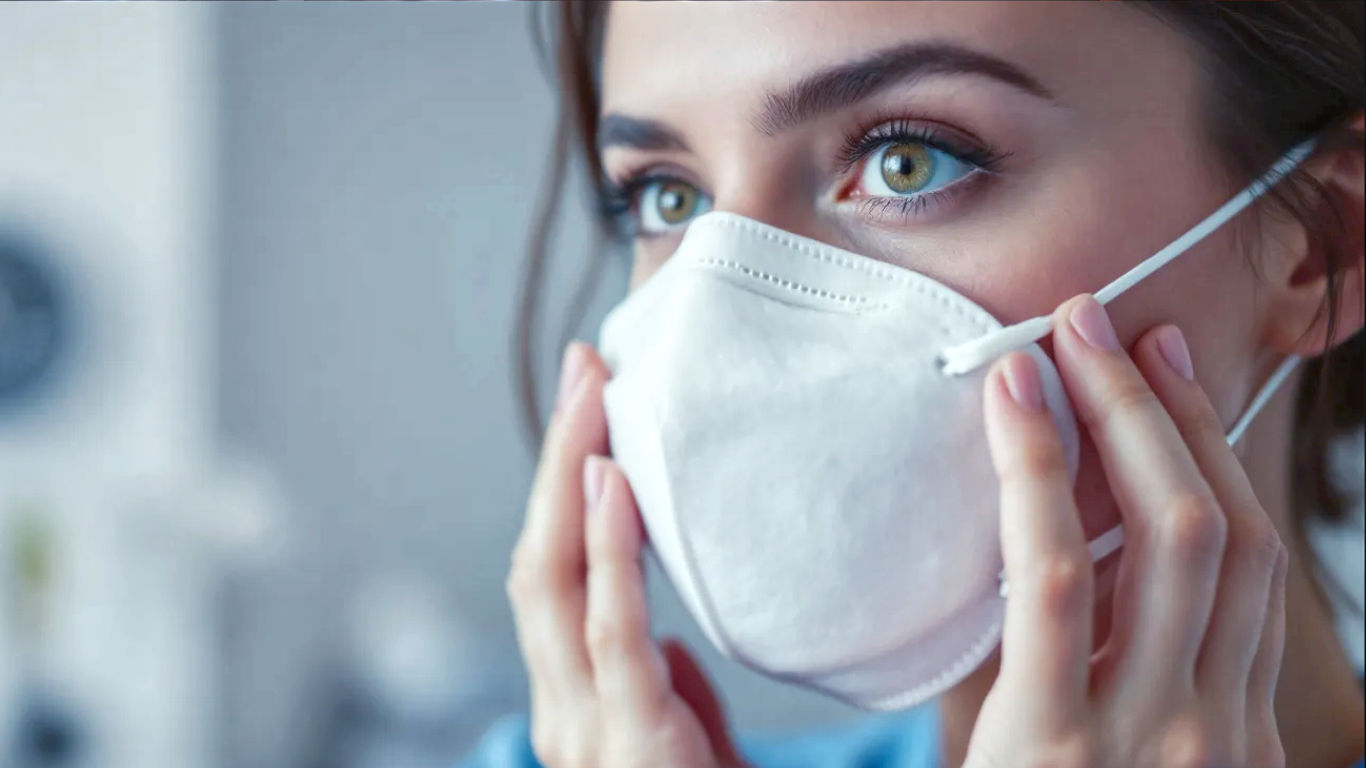FFP3 Face Masks: The Ultimate Guide to Respiratory Protection
Your definitive guide to FFP3 masks. We explain the science, the UK standards, and the practical steps for choosing and fitting the highest level of respiratory protection.

This post may contain affiliate links. If you make a purchase through these links, we may earn a commission at no additional cost to you.
Ever wondered what the difference is between that flimsy blue mask you see everywhere and the heavy-duty ones builders or doctors wear? It’s a bit like comparing a paper brolly to a storm-proof umbrella. Both might keep a light drizzle off, but only one will see you through a proper British downpour. When it comes to protecting your lungs from tiny, invisible nasties in the air, you want the best umbrella you can get.
That’s where FFP3 masks come in. These aren’t your average face coverings. They are top-tier pieces of personal protective equipment (PPE) designed to filter out almost everything you don’t want to breathe in. Whether you’re a professional working with hazardous dust, a healthcare worker on the front lines, or just someone who wants the highest level of protection available, understanding FFP3 masks is key.
This guide will break it all down. We’ll explore what those letters and numbers actually mean, how these masks work their magic, and why they became such a hot topic. We’ll look at their history, from grimy industrial workshops to sterile hospital wards, and give you the practical know-how to choose, fit, and use one correctly. Think of this as your complete handbook to breathing easier and safer.
What on Earth is an FFP Mask?
Let’s start with the basics. The term ‘FFP’ stands for “Filtering Face Piece.” It’s a European standard for disposable respiratory masks that are tested and certified to protect you from breathing in particles like dust, pollen, viruses, and bacteria.
Imagine you’re trying to catch tiny particles with a net. A simple cloth mask is like a fishing net—it’ll stop the big fish but lets all the little ones swim right through. An FFP mask is more like a super-fine sieve, designed to catch even the smallest specks.
There are three levels of FFP protection, and it’s all about how good that sieve is:
- FFP1: The entry-level mask. It filters at least 80% of airborne particles. It’s fine for low-level dusts you might find doing a bit of DIY at home, but it won’t stop much else.
- FFP2: A big step up. This one filters at least 94% of airborne particles. You’ll often see these used in workplaces with more serious dust or during health outbreaks. They’re roughly the equivalent of the American N95 standard.
- FFP3: The gold standard. This mask filters a whopping 99% or more of airborne particles. It’s the highest level of protection you can get from a disposable respirator in Europe.
So, when we talk about an FFP3 mask, we’re talking about a device that provides the maximum level of filtration, designed to protect against very fine, toxic particles, including asbestos, bacteria, and viruses.
The Secret Ingredient: How Filtration Actually Works
You might think an FFP3 mask is just a very thick piece of fabric, but the technology is much cleverer than that. The filter material is made of a tangled web of tiny synthetic fibres, creating a complex maze for particles to navigate.
Filtration isn’t just about straining particles out like pasta in a colander. It happens in several ways at once:
- Direct Interception: Large particles, like visible dust, simply can’t fit through the gaps in the fibre maze and get stuck. It’s like a football hitting a chain-link fence.
- Inertial Impaction: Medium-sized particles have some weight to them. As air zips and curves around the fibres, these heavier particles can’t change direction quickly enough. They keep going in a straight line and slam into a fibre, getting trapped.
- Diffusion (Brownian Motion): This is where it gets really clever, especially for the tiniest particles like viruses. These ultra-fine particles are so light they don’t travel in a straight line. Instead, they get knocked about by air molecules and zigzag randomly. This chaotic dance makes it almost certain they’ll bump into a fibre and stick to it.
- Electrostatic Attraction: The filter material in most FFP3 masks is given a static charge. Think of it like the static electricity that makes a balloon stick to your jumper. This charge actively pulls particles out of the air and makes them cling to the fibres, even if they don’t physically touch them.
It’s this combination of methods that allows an FFP3 mask to catch an incredible 99% of particles, big and small.
Valve vs. Non-Valved: What’s the Difference?
You’ll notice that some FFP3 masks have a little plastic circle on the front, while others don’t. This is an exhalation valve.
- Valved FFP3 Masks: The valve is a one-way flap. When you breathe in, it stays shut, so all the air you breathe comes through the filter. When you breathe out, the valve opens, letting your warm, moist air escape easily. This makes the mask much more comfortable to wear, especially for long periods or if you’re doing physical work. It reduces heat and moisture build-up, so you don’t feel as stuffy.
- Non-Valved FFP3 Masks: These masks have no valve. The air you breathe in and out goes through the filter material.
So which is better? It depends on why you’re wearing it.
If your main goal is to protect yourself from what’s in the air (like dust on a building site), a valved mask is often more comfortable.
However, if you’re trying to protect other people from your own germs (like in a hospital or during a pandemic), a non-valved mask is the only choice. A valve lets your unfiltered breath out, so if you’re ill, you could still spread germs. This is why non-valved masks are mandatory in sterile environments.
The Journey of the FFP3 Mask: From Factory Floor to Global Frontline
The idea of filtering the air we breathe isn’t new. As far back as Roman times, Pliny the Elder wrote about miners using animal bladders to avoid inhaling lead dust. But the story of the modern FFP3 mask really begins with the Industrial Revolution in Britain.
As factories, mines, and mills sprang up across the country, workers were exposed to horrendous levels of dust and fumes. Lung diseases like silicosis from stone dust and “black lung” from coal dust were devastatingly common. Early attempts at protection were grimly basic—workers might tie a damp cloth over their face, which offered barely any protection.
The Birth of Modern Respirators
Things started to change in the early 20th century. During World War I, the horror of chemical warfare spurred the development of gas masks. This was a huge leap forward in respiratory technology, proving that it was possible to filter out deadly substances from the air.
After the war, this technology began to trickle down into industrial use. Companies started creating respirators with replaceable filter cartridges to protect workers. However, these were often big, bulky, and uncomfortable.
The real breakthrough came in the 1970s. Scientists developed a way to give filter materials an electrostatic charge, dramatically improving their efficiency without making them harder to breathe through. This innovation paved the way for the lightweight, disposable FFP-style masks we know today.
The UK and European Standards
To make sure these masks were actually effective, standards were needed. In the UK, the Health and Safety Executive (HSE) has long been responsible for setting workplace safety rules. Across Europe, the European Committee for Standardization (CEN) developed the “EN 149” standard, which defines the FFP1, FFP2, and FFP3 categories.
A mask can only be sold as an FFP3 mask in the UK and Europe if it has been independently tested and certified to meet these strict performance criteria. This is your guarantee that it does what it says on the tin. Look for the CE mark (or the new UKCA mark in Great Britain) on the mask and its packaging. This shows it conforms to the required standards.
FFP3 in the Spotlight: The COVID-19 Pandemic
For most of its history, the FFP3 mask was a specialist bit of kit, familiar mainly to builders, factory workers, and certain healthcare professionals. The COVID-19 pandemic changed that forever.
Suddenly, terms like “aerosol transmission” and “respiratory protection” were on everyone’s lips. As scientists realised the virus could spread through tiny airborne particles, the demand for high-filtration masks skyrocketed.
In the UK, the debate around PPE for NHS staff became a major national story. The key question was what level of protection was needed. Initially, many healthcare workers were given standard surgical masks. But as understanding of the virus grew, unions and medical bodies began demanding FFP3 masks for staff working in the most high-risk situations, known as aerosol-generating procedures (AGPs). These are medical treatments, like putting a patient on a ventilator, that can spray virus-laden particles into the air.
The government faced a massive challenge to secure enough FFP3 masks for the NHS and social care. Global supply chains collapsed, and prices soared. This crisis highlighted just how critical these unassuming pieces of equipment are in protecting frontline workers. It also brought FFP3 masks out of the workplace and into the public consciousness.
Putting It On: A Practical Guide to Using an FFP3 Mask
An FFP3 mask is only as good as its fit. A mask with a 99% filtration efficiency is useless if air can just leak in around the edges. Getting a perfect seal is everything. This is why, in professional settings, users must undergo a “fit test” to ensure their mask fits their face shape perfectly.
While you might not have access to a professional fit tester, you can still take steps to get the best fit possible.
Choosing the Right Mask
FFP3 masks come in a few common shapes:
- Cup-shaped: These are rigid, pre-moulded masks that hold their shape. They keep the mask material away from your mouth, which some people find more comfortable.
- Fold-flat: These masks are folded in half or in three panels. They are easy to store and carry around. The multi-panel designs can often provide a better fit for a wider range of face shapes.
The most important factor is finding one that fits your face. A mask that fits your friend perfectly might not fit you. If you can, try different brands and styles to see what works best.
The Step-by-Step Fitting Guide
Always follow the manufacturer’s instructions, but here is a general guide to putting on and checking an FFP3 mask:
- Clean Your Hands: Before you touch the mask, wash your hands thoroughly with soap and water or use an alcohol-based hand sanitiser.
- Inspect the Mask: Check the mask for any damage—holes, tears, or broken straps. Don’t use a damaged mask.
- Position the Mask: Hold the mask in your palm with the nosepiece at your fingertips. For a cup-shaped mask, the straps should hang freely below your hand. Place the mask over your nose and mouth, holding it in place with one hand.
- Secure the Straps: Pull the bottom strap over your head and position it around your neck, below your ears. Then, pull the top strap over your head and place it on the crown of your head, above your ears. The straps should be flat and untwisted.
- Mould the Nosepiece: Using the fingertips of both hands, press down on the metal nosepiece to mould it firmly to the shape of your nose bridge. Don’t pinch it with one hand, as this can create a poor seal.
- Perform a Fit Check: This is the most crucial step.
- Place both hands completely over the mask.
- Breathe in sharply. The mask should pull in slightly towards your face. If it does, you have a good seal.
- Breathe out sharply. You should not feel any air leaking out around the edges of the mask, especially around your nose or cheeks.
- If you feel air leaking, readjust the mask, straps, and nosepiece, and repeat the check.
A note on facial hair: Beards and even heavy stubble are the enemy of a good mask seal. The hair creates gaps between the mask and your skin, allowing contaminated air to leak in. For an FFP3 mask to work properly, you need to be clean-shaven where the mask seals against your face.
When to Wear (and When to Replace) an FFP3 Mask
FFP3 masks are designed for specific, high-risk situations.
In the Workplace:
- Construction and Woodworking: Protecting against fine dusts from concrete, silica, wood, and insulation materials.
- Healthcare: Used during AGPs and when caring for patients with highly infectious airborne diseases.
- Manufacturing: Protection from chemical powders, metal fumes, and other hazardous particles.
- Agriculture: Shielding against mould spores from hay and grain dust.
For Personal Use:
- Vulnerable Individuals: People with weakened immune systems may choose to wear them in crowded indoor spaces during flu season or other outbreaks.
- Severe Air Pollution or Wildfire Smoke: FFP3 masks can filter out the harmful fine particulate matter (PM2.5) found in smoke and smog.
These masks are disposable and not designed for endless use. You should replace your mask if:
- It becomes damaged or distorted.
- It becomes dirty or contaminated.
- Breathing through it becomes difficult (this means the filter is getting clogged).
- The seal is no longer effective.
Manufacturers often give a recommended maximum usage time, typically around 8 hours of cumulative use, but you should always replace it sooner if you notice any of the issues above.
The Future of Respiratory Protection
The experiences of recent years have fundamentally changed how we think about the air we breathe. This has sparked a new wave of innovation in respiratory protection, with researchers and companies in the UK and beyond working on the next generation of masks.
Smarter and More Comfortable Materials
One of the biggest challenges with FFP3 masks is comfort. The tight fit and dense filter can make them hot and hard to breathe through for long periods. Future masks might use new materials with even better filtration efficiency but lower breathing resistance.
Some researchers are looking at incorporating nanofibres into filters. These ultra-thin fibres can create an incredibly dense web to trap particles more effectively, potentially allowing masks to be thinner and more breathable.
Reusable and Sustainable Options
The pandemic created mountains of plastic waste from disposable PPE. This has pushed the search for effective, reusable alternatives. We are already seeing the emergence of elastomeric respirators—reusable masks made of silicone or rubber with replaceable filter cartridges, much like the old industrial models but far more comfortable and advanced.
There is also research into self-sterilising masks. These could incorporate materials like copper or special coatings that can kill viruses and bacteria on contact, potentially allowing them to be worn safely for longer.
A New Culture of “Clean Air”
Perhaps the biggest change will be cultural. Just as the Victorians learned to build sewer systems to stop the spread of cholera, we are now much more aware of the importance of clean indoor air.
This could lead to a future where high-quality masks are a normal part of life, used during seasonal virus outbreaks in the same way people in some Asian countries have done for years. It will also drive improvements in building ventilation and air filtration systems, reducing the need for masks in the first place. The FFP3 mask, once a niche piece of industrial gear, has become a symbol of a new understanding of health and safety, reminding us that sometimes the greatest threats are the ones we cannot see.
Further Reading
For those who wish to delve deeper into the official standards and guidance, these resources are highly recommended:
- Health and Safety Executive (HSE) – Respiratory Protective Equipment at Work: The definitive UK government guidance on all aspects of RPE.
- NHS England – National Infection Prevention and Control Manual (NIPCM) for England: Detailed guidance for healthcare workers on PPE usage.
- British Occupational Hygiene Society (BOHS): Expert advice on hygiene safety in the workplace.






